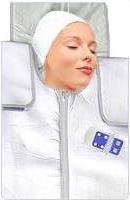. Home|View Shopping Cart|Privacy Policy|Contact Us
AlkalizingNutrition.com
The
Fundamentals of Vibrant Health
News from Scientific America
January 22, 2003Bone Marrow Stem Cells Reach Brain and Acclimate
by Sarah GrahaA new study underscores the promise of adult stem cells for changing into other useful cell types. The results, published online this week by the Proceedings of the National Academy of Sciences, reveal that transplanted bone marrow cells can migrate to a recipient's brain and transform into neurons.
Previous research had indicated that stem cells isolated from adult bone marrow could be coaxed to turn into neurons in a petri dish. In addition, other findings had shown that transplanted bone marrow cells in mice could travel to the brain and differentiate into neurons. In the new work, Éva Mezey of the National Institutes of Health and her colleagues analyzed brain samples from four human females who had received bone marrow transplants from male donors before they died. The scientists looked in the brain tissue for cells that contained a Y chromosome and thus must have come from the male donors. As it turns out, all four patients had such cells. Most of these were support cells known as glia, and other nonneuronal cells. A small number of the Y-chromosome-containing cells in each woman were neurons, however. "This study shows that some kind of cell in bone marrow, most likely a stem cell, has the capacity to enter the brain and form neurons," Mezey says. The male-derived cells were found in clumps, suggesting that a single bone marrow stem-cell may migrate to an area in need before differentiating into a number of cell types, the scientists offer.
The findings hold promise for possible future treatments for neurological disorders from a noncontroversial source--a patient's own bone marrow. But much research remains to be done. Because the patient with the greatest number of bone-marrow derived neurons had survived the longest after her transplant (and was also the youngest recipient), it is unclear which factors determine how many neurons can be generated by bone-marrow stem cells. Further clouding the issue is the fact that adult stem cells have been shown in some cases to fuse with previously differentiated cells instead of forming entirely new cells. Although Mezey and her colleagues did not find any evidence of fusion (namely cells with four sex chromosomes instead of two) the possibility cannot yet be ruled out. "These studies are very much the beginning," Mezey says, "but scientists should start to look down this road and find out if and how we can go further." -- Sarah Graha Web link Scientific America
Return To StemEnhance Page
Important StemEnhance Linksks
StemEnhance Official Website
StemEnhance™ Patent
StemEnhance Triple Blind Study
StemEnhance Business Opportunity Power Point Presentation
StemEnhance Business Opportunity Explained in English
StemEnhance Business Opportunity Explained in Spanish
Distributorship Signup
The statements enclosed herein have not been evaluated by the Food and Drug Administration. The products mentioned on this site are not intended to diagnose, treat, cure, or prevent any disease. Information and statements made are for education purposes and are not intended to replace the advice of your family doctor.
|
FEATURED
PRODUCTS
The Chi Machine
Understanding
FIR
Mattresses
FIR
Healing Lamps
FIR Sauna
Domes
|
||||||
|












